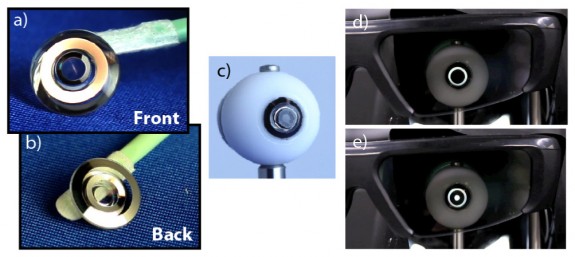These Contact Lenses Can Zoom In and Out, Give You Telescopic Vision
These contact lenses can switch your vision back and forth from regular sight to a 2.8x zoom

The new contact lens from the front and the back (a and b), on a fake eye (c), and with the magnifying view off and on (d and e). Photo: Tremblay et al.
Putting in your contact lenses can sometimes feel like you’re donning a pair of telescopes, snapping distant blurs into sharp focus. A new, experimental set of contact lenses makes that feeling that much more real: these lenses zoom vision in and out by a factor of 2.8.
Designed by a team of engineers lead by the University of California—San Diego’s Eric Tremblay, the contact lenses are being billed as a possible cure for macular degeneration. But dreams of superhero-style super-sight pervade the press. And with the work being funded by DARPA, the U.S. Department of Defense’s research arm, thoughts of super soldiers might not be too far off base.
For New Scientist, Paul Marks describes how it works:
Just over a millimetre thick, the telescopic lens works by having a central unmagnified optical path that is surrounded by a ring of optics that magnify the view 2.8 times. Liquid crystal shutters then block one or the other of these optical paths – allowing the user to switch between regular and magnified vision.
For now, says Marks, you have to wear a set of 3D TV glasses with the contact lens to make the switch from regular to telescopic vision. He says the team “is confident that the LCD technology can be built into the lens easily – but how it will be switched on and off has yet to be revealed.”
The contact lens is still rough around the edges, and issues with the design mean that zooming in gives the wearer a fuzzy view, rather than a crisp enhancement.
If they can improve those issues, say the study’s authors, this approach to super vision should supplant the current leading fix for degenerating vision—“implantable intraocular miniature telescope.” Right now, surgeons can implant a small telescope in your eye: “The IMT is available in magnifications of 2.2x and 2.7x at ~F/12.5 and includes two small air-spaced glass lenses encased in a plastic lens tube implanted into one of the patient’s eyes in place of the crystalline lens.” Contact lenses do seem simpler.
More from Smithsonian.com:
Sci-fi Contact Lenses Get Closer to Reality
Embedded Technologies: Power From the People
/https://tf-cmsv2-smithsonianmag-media.s3.amazonaws.com/accounts/headshot/smartnews-colin-schultz-240.jpg)
/https://tf-cmsv2-smithsonianmag-media.s3.amazonaws.com/accounts/headshot/smartnews-colin-schultz-240.jpg)